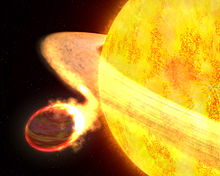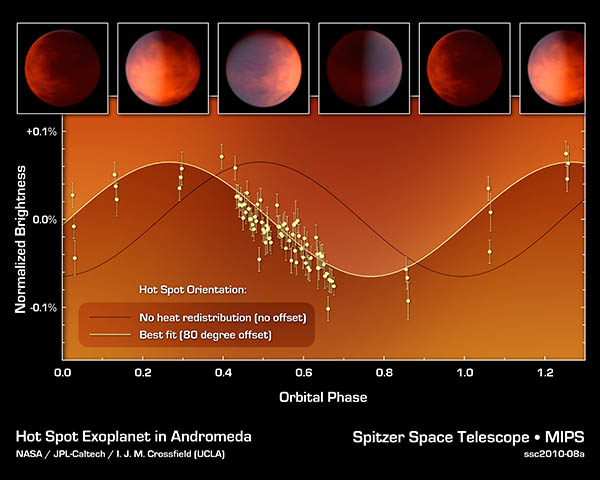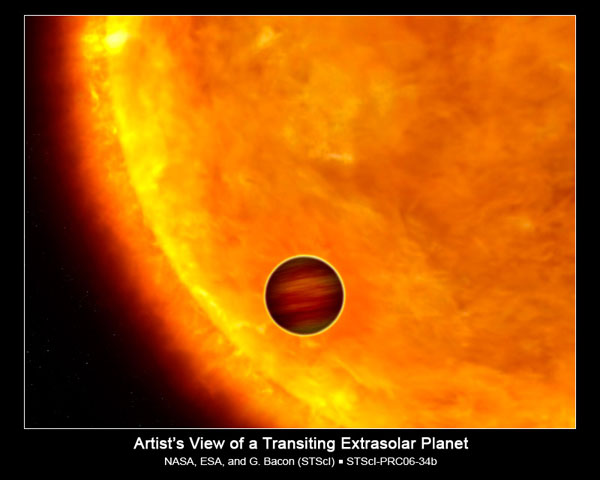KU Dept. of Physics and Astronomy
1082 Malott,1251 Wescoe Hall Dr.
Lawrence, KS 66045
email : ianc@ku.edu
Research Interests
Recent Results:
2022 Aug: With the help of ExoLab grad student Yoni Brande and Prof. Ian Crossfield, NASA's James Webb Space Telescope has captured an astonishingly detailed rainbow of near-infrared starlight filtered through the atmosphere of a hot gas giant 700 light-years away. The transmission spectrum of exoplanet WASP-39 b, based on a single set of measurements made using Webb’s Near-Infrared Spectrograph and analyzed by dozens of scientists, represents a hat trick of firsts: Webb’s first official scientific observation of an exoplanet; the first detailed exoplanet spectrum covering this range of near-infrared colors; and the first indisputable evidence for carbon dioxide in the atmosphere of a planet orbiting a distant star. The results are indicative of Webb’s ability to spot key molecules like carbon dioxide in a wide variety of exoplanets – including smaller, cooler, rocky planets – providing insights into the composition, formation, and evolution of planets across the galaxy. Read the official press release and/or the paper to be published in Nature.

2022 Jul: The rapid rate of exoplanet discovery in the last two decades has been accompanied by a push to better understand the stars that host them - in particular, by comparing the chemical compositions of planets with their stars. JWST has already begun to conduct its first observations of the atmospheres of other worlds, making a uniform determination of their host star abundances an important and timely step in the interpretation of those results. Grad student Alex Polanski published an assay of 15 elemental abundances in 25 roughly Sun-like stars being targeted in the first year of JWST's exoplanet observations. See Alex's plots here, or go and read the Research Note.
2022 Jan: The recently discovered planet TOI-674b, a bit bigger than Neptune and orbiting a red-dwarf star about 50 parsecs away, places it in an exclusive club: exoplanets, or planets around other stars, known to have water vapor in their atmospheres. That's thanks to ExoLab grad student Yoni Brande's recent measurements using the Hubble Space Telescope's WFC3/G141 spectrograph. Many questions remain, such as how much water vapor its atmosphere holds. But TOI-674 b’s atmosphere is far easier to observe than those of many exoplanets, making it a prime target for deeper investigation. Read the JPL press release, the KU press release, and read the full paper here.
2021 Dec: Each decade, prominent scientists convene and produce a research roadmap for astronomy and astrophysics under the sponsorship of NAS. The "decadal survey" is meant to make sure the United States stays at the forefront of astronomy and astrophysics. Two scientists from the University of Kansas - ExoLab PI Ian Crossfield and astroparticle professor David Besson contributed to the Decadal Survey on Astronomy and Astrophysics 2020. Read about KU's contributions here, and read more about the 2020 Decadal Report here at the National Academies website.
2020 Sep: So-called "White Dwarfs" are the dying embers of former stars like our sun. Known for over a century, these small, dense objects are intrinsically very faint and so much tougher to study than larger, hotter, brighter stars. In a first-of-its-kind discovery, our research group was part of the team that just discovered the first known planet orbiting one of these white dwarfs. The planet is a large, cool, Jupiter-like gas giant with a "year" (the time it takes it to orbit once around the white dwarf) of just over 30 hours. Read more about it here at KU and at at NASA.
2019 Jan: Low-mass M dwarfs represent the most common outcome of star formation, but their complex atmospheres (filled with molecules such as H2O) hinder detailed studies of their composition and initial formation. The measurement of isotopic ratios is a key tool that has been used to unlock the formation of our Solar System, the Sun, and the nuclear processes within more massive stars, and our team applied the study of 12C16O, 13C16O, and 12C18O for the first time to any dwarf stars beyond the Solar system. Since the stars are fully convective, their atmospheres should be uniformly mixed and so our observations directly probe the conditions and composition of natal gas making up these stars. These measurements poze a puzzle for models of how our Milky Way galaxy, and stars in the Solar neighborhood, formed; we intend for our novel isotopic analysis to open a new window onto studies of Galactic evolution, stellar populations, and individual systems. You can read about our results, published in ApJ Letters, online here.
2019 Sep: Surveys for new planets using the transit and radial velocity techniques reveal the high frequency with which small, short-period planets occur around main sequence stars. However, only a few of these smaller planets can be easily observed to characterize their atmospheres or masses. Our team used data from NASA's TESS spacecraft to identify the third-coolest star known to host planets: LP 791-18 is a star less than twice the size of Jupiter that hosts two small planets: a hot, presumably rocky "super-Earth" and a larger, somewhat cooler (though still warm!) "sub-Neptune". Read all about it online here.
2018 Jun: Surveys for new planets using the transit and radial velocity techniques reveal the high frequency with which small, short-period planets occur around main sequence stars. However, only a few of these smaller planets can be easily observed to characterize their atmospheres or masses. Our team continues its rapid-response planet survey using Kepler/K2 by providing lists of planet candidates within a month of data downlink from each of K2's forward-facing campaigns. These include dozens of planet candidates in both Campaigns 16 and 17, which you can read about here and here.
2017 Apr: Our citizen-science K2 research program with Zooniverse has gone live. In this project, we aim to use K2 to measure the intrinsic occurrence rates of different types of planets orbiting different types of stars. Are small planets (like Venus) more common than big ones (like Saturn)? Are short-period planets (like Mercury) more common than those on long orbits (like Mars)? Do planets more commonly occur around stars like the sun, or around the more numerous cooler, smaller "red dwarfs"? We hope you will join the team and help us in our exoplanet exploration!
2016 Jul: Our team has just announced the discovery of hundreds of
planet candidates from K2, including over 100 fully validated
planets. These true, bona fide planets (no longer mere candidates!)
provide an excellent laboratory for measuring planet masses (via RVs
and TTVs), atmospheric composition (with HST and JWST), and for
studying planetary habitability. Read all about the new results
online here, here, here,
or here,
or read the full
paper here.
Also of interest is my recent invited review of Observations of Exoplanet Atmospheres. Detailed atmospheric characterization of exoplanets provides the best hope for distinguishing their makeup, and the only hope for understanding the interplay between initial composition, chemistry, dynamics and circulation, and disequilibrium processes. This article gives an observer's perspective on the current understanding of extrasolar planet atmospheres prior to the considerable advances expected from the next generation of observing facilities. Atmospheric processes of both transiting and directly imaged planets are discussed, including molecular and atomic abundances, cloud properties, thermal structure, and planetary energy budgets. In the future we can expect a continuing and accelerating stream of new discoveries, which will fuel the ongoing exoplanet revolution for many years to come.
2015 Jan: Surveys for new planets using the transit and radial velocity techniques reveal the high frequency with which small, short-period planets occur around main sequence stars. However, only a few of these smaller planets can be easily observed to characterize their atmosphere; even fewer are known around low-mass M stars, though these planetary systems may be the most common in the Galaxy. Our team has just discovered three small planets orbiting a bright, nearby M star using data collected by K2, a new mission using the re-purposed Kepler spacecraft. We find that the system hosts three transiting planets, all with sizes just 1.5 to 2 times larger than the Earth. Thus these new planets likey straddle the transition region between rocky and increasingly gas-dominated compositions. With an orbital period ('years') of 45 days, the third planet receives roughly as much heat from its star as do Earth or Venus, placing the planet near its star's habitable zone and making it one of the coolest small planets known orbiting a nearby star. The bright, low-mass star makes this system an excellent laboratory to determine the planets' masses via Doppler spectroscopy and to constrain their atmospheric compositions via transit observations with the Hubble and James Webb Space Telescope. Download the paper or read all about it here.
First Global 2D Map of an Extrasolar Substellar Body
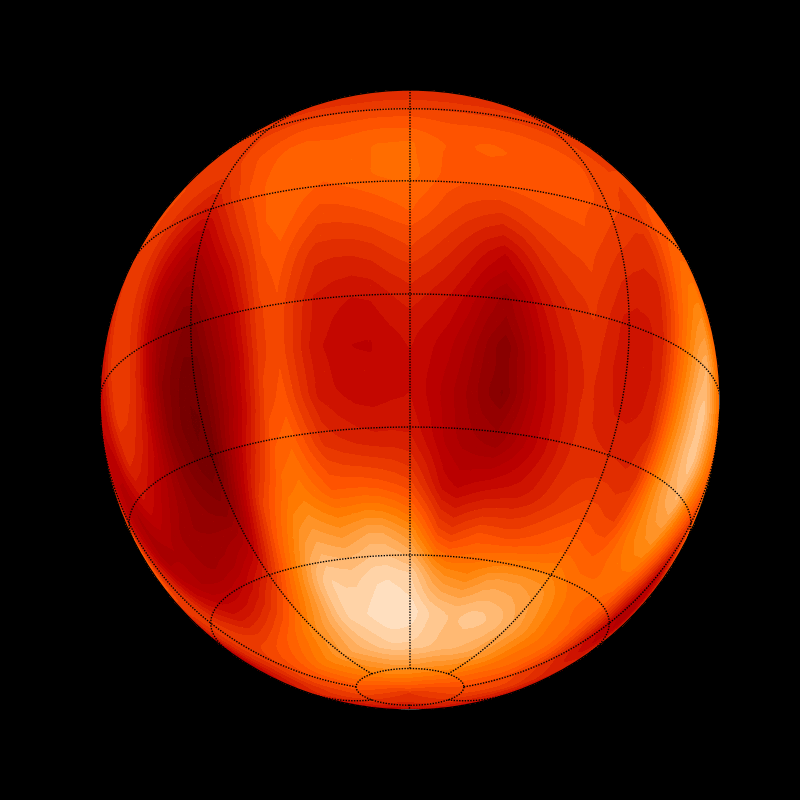
Map of Luhman 16B: the first global map of a brown dwarf. Bright regions are gaps in the clouds, where infrared light from the hotter, deeper atmosphere can escape to space.
(I. Crossfield, MPIA)
Atmospheric Studies of Cool planets
2013 Sep: Surveys for new planets using the transit and radial velocity techniques reveal the high frequency with which small, short-period planets occur around main sequence stars. However, only a few of these smaller planets can be easily observed to characterize their atmosphere. One such planet is GJ 3470b, which is about the size and mass of Uranus but much hotter: over 300 C (550 F). I led an analysis of this planet by observing the planet's transit with the new Keck/MOSFIRE spectrograph to look for evidence of water or methane absorption in the planet's atmosphere from 2.09-2.36 micron. As seen for other small, cool, low-mass planets, the current ensemble of measurements is consistent with a flat transmission spectrum, which suggests that the atmosphere is explained by some combination of high-altitude clouds and haze, disequilibrium chemistry, unexpected abundance patterns, or an extremely metal-rich atmosphere. Read our full paper here.Our analysis predicted that transit observations at shorter wavelengths would provide the best opportunity to discriminate between plausible scenarios. Indeed, a simultaneous and independent analysis using optical photometry shows strong evidence for Rayleigh scattering in GJ 3470b's atmosphere, consistent with an atmosphere dominated by a scattering haze. If this haze is not too optically thick, GJ 3470b's relatively deep primary transit, bright host star, and low density will permit a detailed characterization of its atmosphere via transmission spectroscopy during transit.
Studying Small, Cool, Nearby Exoplanets
2013 Jan: Surveys for new planets using the transit and radial velocity techniques are beginning to reveal the frequency with which small, short-period planets occur around main sequence stars. Using these results, I have made the first direct prediction of the number and types of such planets that will be amenable to direct characterization by high-contrast instruments on future giant segmented-mirror telescopes. I predict of order 10 planets should be accessible around stars within 8 pc of the Sun; these planets will have sizes from 1-8 Earth radii and have equilibrium temperatures under 400 K. In particular, I predict a 40% chance that a 1-2 Earth radius planet and an equilibrium temperature comparable to Earth's (200-250 K) will accessible to high-contrast thermal infrared characterization; this would be an exciting object to study! Several planets already discovered by radial velocity surveys will be accessible to near-infrared high-contrast GSMT observations, including those around the nearby stars alpha Cen, GJ 139, GJ 876, and tau Cet. In the paper, I suggest that theorists begin to explore the range of possible atmospheric and/or surface compositions of these planets, and that more work should be done to precisely characterize the stars in the solar neighborhood. Read the full paper (accepted to A and A).Re-evaluating hot Jupiter WASP-12b
2012 Nov: The hot Jupiter WASP-12b is one of the largest and hottest transiting planets, and has been studied by many groups; on the basis of these analysis, the planet has been claimed to have a very high carbon to oxygen ratio in its atmosphere. Such a carbon-rich atmosphere is predicted to show strong absorption features from carbon monoxide at a wavelength of 2.31 microns. We observed this planet with the Subaru Telescope and found no absorption at this wavelength: instead, our observations are consistent with a featureless spectrum, indicating an atmosphere whos temperature is approximately constant with altitude. Therefore our results argue against the current carbon-rich interpretation for this planet. Our analysis is being published in the Astrophysical Journal; read it here or read Caroline Morley's summaryhere on Astrobites.Precise 24 micron Observations of HD 209458b
2012 June: The transiting hot Jupiter HD 209458b was the first known transiting planets, and is one of the best studied. Because it is one of the few transiting planets that was known during the Spitzer Space Telescope's cryogenic mission, HD 209458b has been characterized over a broader range of wavelengths than have most transiting planets. We recently conducted an archival analysis of all 24 micron observations of this planet to derive a homogeneous set of mid-infrared parameters for this system. Our analysis provides the most precise 24 micron eclipse measurement of any known planet; along with transit observations, our work demonstrates once again that this short-period planet's orbit is precisely consistent with zero eccentricity.
Unraveling the mystery of GJ 1214b
2011: The nearby star GJ 1214 hosts a planet intermediate in radius and mass between Earth and Neptune, resulting in some uncertainty as to its nature. We have observed this planet, GJ 1214b, during transit with the near-infrared NIRSPEC spectrograph on the Keck II telescope to characterize the planet's atmosphere. When taken in concert with constraints from other groups, our results support a consensus model in which the atmosphere of GJ 1214b contains significant H and He, but where methane is depleted. Our paper has been published in the Astrophysical Journal; you can access the official version (or free preprint) here, or read Caroline Morley's summary here on Astrobites.
upsilon Andromedae b's phase curve:
2010: We report a new 24 micron phase curve for the planet upsilon Andromedae b, showing that the hottest part of the planet (at that wavelength) is shifted 80 degrees from the substellar point. This is a much larger shift than has been seen on other planets (ref1, ref2, ref3), and it's certainly not clear (at least, to me) what could be responsible for such a large shift of the planet's hot regions. See the Spitzer Press Release, or read the paper here.
Exoplanet Characterization
My primary research interest lies in the field of exoplanetary formation, detection, and characterization. While at JPL I had the good fortune to work with Dr. Mark Swain of the JPL Exoplanet Center. Our work focused on ground-based spectroscopic observations of transiting extrasolar planets. By comparing observations in and out of secondary eclipse we hoped to be able to draw conclusions about the composition of the exoplanet atmosphere. A paper describing our results is in preparation, pending follow-up observations confirming our initial findings.
Instrumentation
Gemini Planet Imager
"The Gemini Planet Imager is the next generation adaptive optics instrument being built for the Gemini Telescope. The goal is to image extrasolar planets orbiting nearby stars." --(GPI website). The GPI is being constructed by a consortium of institutions including UCSC, UCLA, University of Victoria, Universite de Montreal, JPL, and probably a few others. It is scheduled to see "first light" on the Gemini South telescope sometime in 2010.
At NASA/JPL I worked on GPI's backend wavefront calibration system, which will allow the measurement and removal of residual and non-common path wavefront errors in the GPI optics.Thirty Meter Telescope
The Thirty Meter Telescope (TMT) is a collaborative project between the University of California, Caltech, ACURA, and other partners. It is an effort to develop the world's largest optical and near-infrared telescope, offering unprecendented sensitivity and resolution. According to current plans, construction of TMT will begin in 2009 or early 2010.I contributed to several aspects of this exciting new facility, but spent most of my time working with the Planet Formation Instrument (PFI), the proposed high-contrast imaging spectrograph for TMT. PFI will ultimately achieve contrast levels of 108-109 at an inner working angle of only 33 milliarcseconds in H band, allowing the first detections and characterizations of mature, reflected-light jovian planets in significant numbers. Among other tasks, I used the stringent requirements set by PFI to "backwards design" the telescope system so that these ambitious goals will not be precluded. This resulted in the first referreed publication discussing the use of a specific high-contrast imaging method on an extremely large segmented telescope.
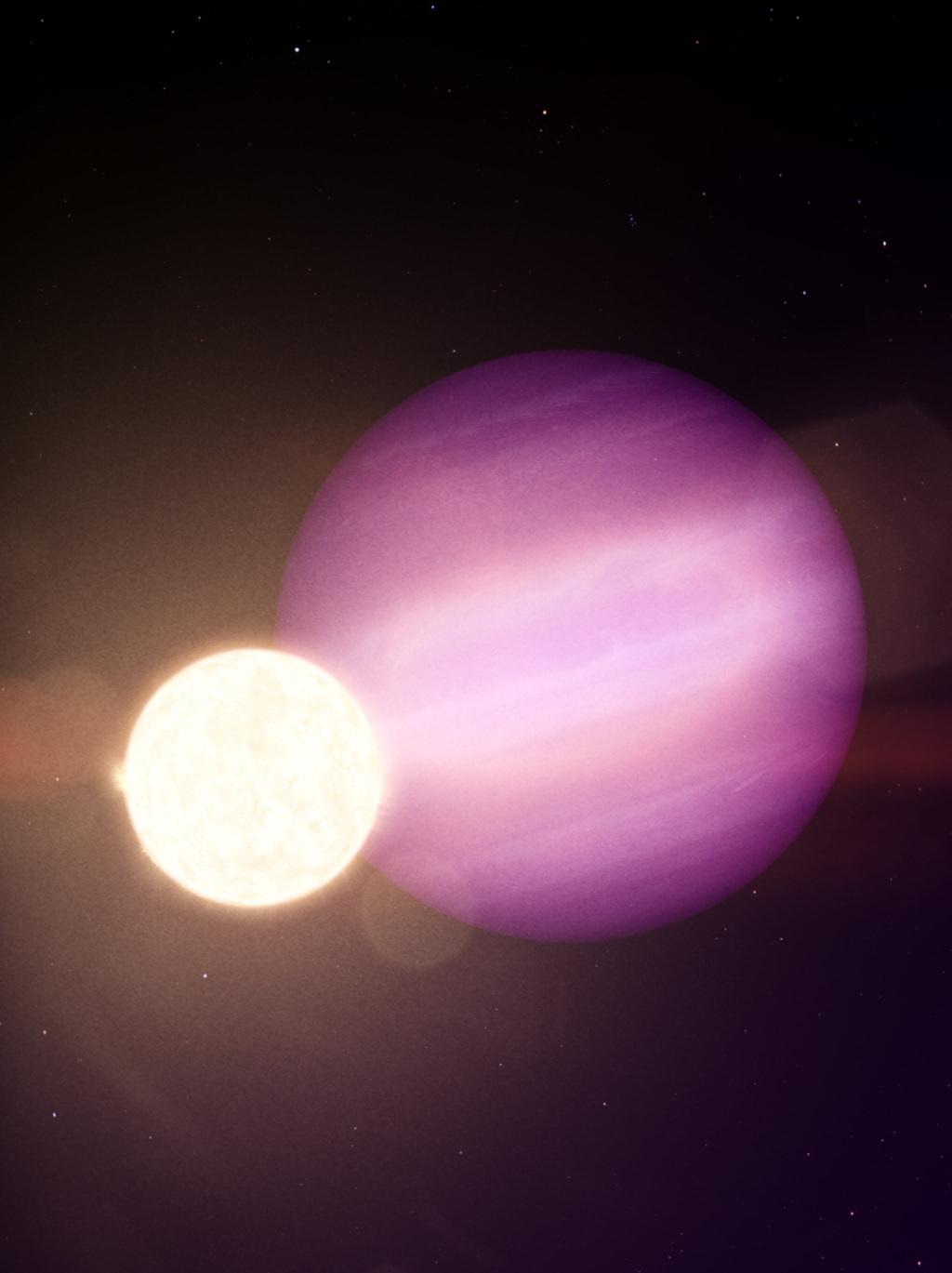
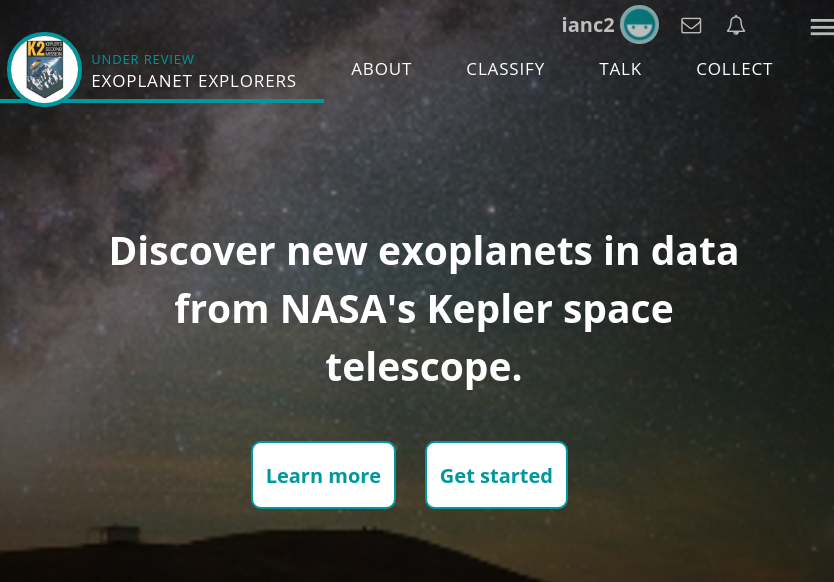

.jpg)

